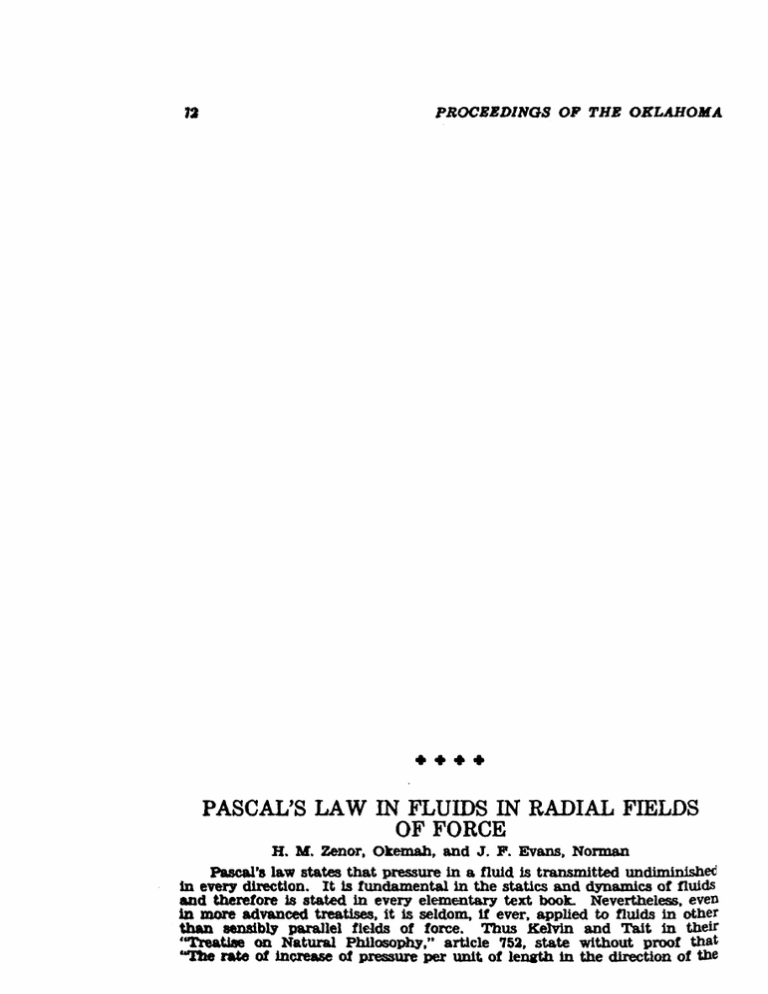Pascal`s Law in Fluids in a Radial Fields of Force
advertisement

72 PROCEBDINGS OF THE OKLAHOMA •••• PASCAL'S LAW IN FLUIDS IN RADIAL FIELDS OF FORCE B. M. zenor, Okemah, and J. P. Evans. Norman Pascal's law states th&t pressure in a fluid is transmitted undiminisbe<J in every direction. It is fundamental in the statics and dynamics of fluids aDd therefore is stated in every elementary text book. Nevertheless. even in more advanced treatises. it is seldom, if ever, applied to fluids in otber than aensibl1 parallel fields of force. Thus.Kelvin and T&1t in their 'arre&tIae on Natural PhUosophy ,n article '152, state without proof that CoIft1e rate of inerease of pressure per unit. of lenath in the dIrection of the ACADEMY OF SCIENCE FOB. 1933 '13 resultant force is equal to the intensity of the force reckoned per unit of volume of the fiuid." This clearly includes the general case of fluids 1n non-parellel fields, yet the same authors afterwards apply it only to the special (but important) case of parallel fields. Some interesting results, however, may be obtained in an elementary manner by applying Pascal's law to fluids in radial fields of force, as will now be shown. The problem of the pressure generated by a centrifugal water pwnp m80Y be simplified by assuming that the angular velocity of the water is everywhere the same. Then by Pascal's law the pressure on the inner arc of an arbitrary infinitesimal of fluid mass p..r dr d theta is transmitted Wld1m1nished to the outer arc, the total pressure at which will therefore be the pressure at the inner arc plus that due to the centrifugal reaction of the whirling element of mass. That 1s, the pressure at any point distant r from the center will be given by the integral P = PI f ~loo2r) + = PI + Y2Poo 2 (Pr dr d theta) (r d t~eta ) Eq. (la) (r2 - r1 2 ) , where PI is the pressure at rl, 00 2 r is the force per unit mass due to the centrifugal reaction and Pr dr d theta is an element of mass. If both PI and rl are zero, P = Y2Pw 2r2 • Eq. <1b) We could have obtained the same result by integrating directly the mathematical expression for the statement above by Kelvin and Tait. dp - - = force per unit mass = w 2 r. dr Or the same result could be obtained starting from the hydrodynamlcal equation of continUity, . ~ = _ p (oVX + oX dt oVy + OVZ) oy oZ as shown in Page's "Introduction to Theoretical Physics." It is instructive to notice that the expression which we have obtained tor the pressure gives for the total force sustained by the outer (cylln~ca1) wall of the pump a quantity greater than the centrigfugal force lIltegrated over all the elements of mass in rotating fluid. Thus 11 we had naively atte-mpted to compute the pressure on the outer wall by asSUDling that the total force supported by it was the summation of all the centrifugal forces acting on the fluid particles, we would have obta.1ned p = _1_ [(2 Pi r1 PI + f a 2 Pi rlP1 = -- a (w 2 r) P r dr d theta) ] rs a 1 pl(J)2 + - -3 a (a3 - r13) Eq. (2a) Which for PI and rl both zero and a == r becomes P = 1/3 P w:l1 r2. Eq. (2b). The Incorrectness of this method. of procedure is Immediately apparent from (280), which tor the case ot (a) == 0 reQuee& to P == riia PI. Th1.I ~ tum PROCEEDINGS OF THE OKLAHOMA tor vanJsb1ng lJ would make the pressure P zero, regardless of the value of the tnit1al pressure PI-which 18 plainly a contradiction to experience, a contradiction recognized, In fact, by a simple application of Pascal's law. The expression of Eel. (2b), however, If multiplied by the area of the external supporting wall, will give the total Integrated radial force acting on all the fiU1d elements, as may be seen by the way in which it was derived. But this is less than the actual total force act.ing on the supporting wall, which is given by multiplying the correct pressure V2 P (a)2 r 2 by the area. The total force o,n the outer wall is therefore greater than the total force acting on the water, in contrast to the usual case in a parallel (gravitational> field, in which the resultant (vector) force acting on the walls of B. vessel is equal to the total weight of the fiuid contained in the vessel. In this case of what we may call a diverging field of force, the total force acting on a given supporting surface is greater than the integrated force acting on all the volume elements. Likewise in a converging radial fteld, such as the gravitational field of the earth, the total force on a given supporting surface is less than the integrated force acting on all the volume elements. The mass of the atmosphere is usually computed by assuming that it is equal to the product of the earth's surface by the pressure (measured in grams weight or pounds weight) per unit area due to the atmosphere. But this does not give the total mass. If the operation of Pascal's law in a radial field is applied to this problem, a value for the mass of the atmosphere will be obtained which is approximately 0.33 per cent greater than the value obtained by making the usual approximations (which amounts to assuming that the earth is flat). The correction here involved is probably not large in comparison with other errors introduced. by neglecting the effects of the earth's rotation and temperature gradients. It is interesting theoretically, however, inasmuch as it shows that the total weight of the atmosphere is not supported by the earth's surface, but that part of the atmosphere-about 0.33 per centJa supported by itself, somewhat on the principle of the arch, 1. e., in the same manner that we might imagine a solid ring encircling the earth at the equator to support Itself by compressional forces, rather than by resting directly on the earth's surface. ••••
